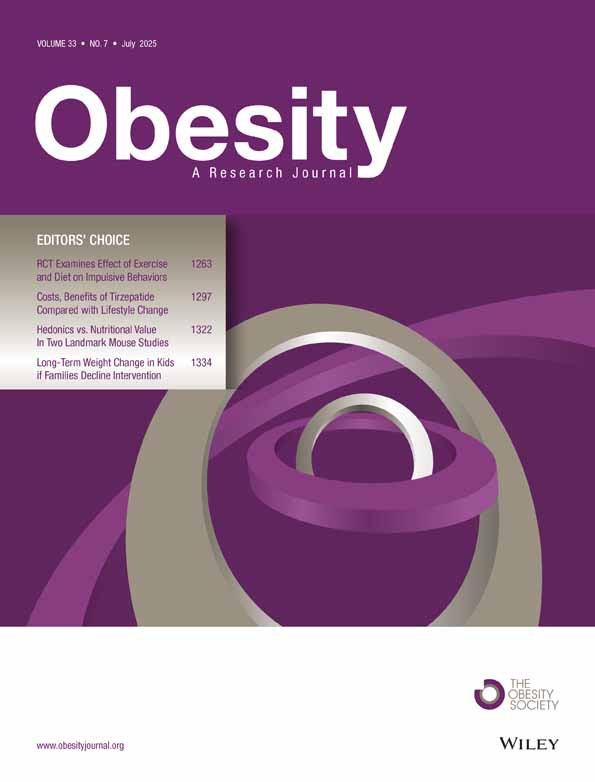Negative Peer Perceptions of Obese Children in the Classroom Environment
Abstract
Objective: It is asserted that the more immediate and observable consequences of pediatric obesity are psychosocial in nature. This study examines the peer relations of clinically referred obese youth compared to demographically comparable nonoverweight peers within the classroom environment.
Methods and Procedures: Peer-, teacher-, and self-reports of behavioral reputation (Revised Class Play (RCP)), and peer reports of social acceptance, nonsocial attributes (attractiveness, athleticism, academic competence), and health interference (school absence, illness, fatigue) were obtained regarding 90 obese youth (BMI > 95th percentile; 8–16 years, 57% girls, 50% African American) and 76 nonoverweight demographically similar comparison classmates.
Results: Relative to comparison peers, obese children were nominated significantly less often as a best friend and rated lower in peer acceptance, although the two groups did not differ in the number of reciprocated friendships. Obese youth were described by peer, teacher, and self-report as more socially withdrawn and by peers as displaying less leadership and greater aggressive-disruptive behavior. Peers also described obese youth as less physically attractive, less athletic, more sick, tired, and absent from school. Being seen as less attractive and less athletic by peers helped to explain differences in obese and nonoverweight youth's levels of peer acceptance.
Discussion: Clinically referred obese youth are characterized by peer relations that differ from those of nonoverweight youth. The peer environment provides a rich context to understand the social consequences of pediatric obesity as well as factors that could be targeted in intervention to promote more positive health and psychosocial outcomes.
Introduction
Obesity is one of today's “most blatantly visible” and stigmatized public health problems (1). As the prevalence (2) and severity (2,3) of pediatric obesity has increased, there has been greater empirical focus on the psychosocial consequences of being an obese child or adolescent. Similarly, there has been increasing discussion of whether there are psychosocial factors that serve as potential barriers or supports in a child's or adolescents' efforts to engage in a healthier lifestyle. This study focuses on not only the social consequences and subsequent risks of pediatric obesity but on whether there are potentially modifiable peer-based factors that could be targeted in obesity prevention and intervention efforts.
Peer relations are central to healthy social and emotional development of all children and adolescents. Through interactions with peers, children learn social skills (e.g., cooperation and competition) and how to establish and maintain close relationships (4,5,6). Poor peer relations in middle childhood are predictive of poorer psychological adjustment (internalizing symptoms, low self-concept, peer rejection) in adolescence (7,8,9), as well as greater psychopathology and poorer developmental adaptation (e.g., school/job performance, interpersonal relations) in adulthood (10,11,12). Certain “nonsocial” attributes, specifically physical attractiveness, athleticism, and academic competence have been shown to be important for success in children's peer relations (13). Further, any health condition, which limits a child's abilities to participate fully in peer activities or affects a child's physical appearance is known to have greater social consequences (14).
Existing literature suggests that obese youth have problematic social functioning. When obese youth are asked directly about their experiences within the peer environment they self-report numerous social difficulties including victimization, name-calling, and teasing about their appearance (15,16,17,18,19). Moreover, in a recent study, obese adolescents reported that not only were they the victims of verbal bullying by peers, but they were also perpetrators of this type of aggression (16). Similarly, parents characterize their obese child or adolescent as experiencing greater social difficulties relative to nonobese youth (20) and instrument normative samples (21,22,23,24). Researchers have also utilized hypothetical peer paradigms (figure-drawings, photographs) to illustrate negative attitudes about obesity within the peer environment. Across these studies, children and adolescents consistently chose negative attributes (“ugly”, “lazy”, “sad”, “poor leader”) to describe an obese “peer” (25,26,27) and ranked an obese “peer” as the “least liked” compared to “peers” portrayed with observable physical conditions or disabilities, as well as nonoverweight “peers” (27,28).
Considerably fewer researchers, however, have used peer-based assessments to examine the actual peer relations of obese youth. Measures of peer relations based upon peer judgments are the favored source of assessment of social functioning available to researchers (29). Peers provide multiple perspectives vs. that of a single rater (e.g., parent, self) and provide information on the “fit” between an individual and peer group norms (30). Conceptual and methodological considerations of peer-based assessments of peer relations have generally advanced in two distinct directions: (i) measures of peer acceptance and friendship (“Is the child liked?”) and (ii) measures of behavioral reputation (“What is the child like?”). Peer acceptance reflects a peer group's “collective attraction” to one child (31). Behavioral reputation is typically assessed via descriptive matching techniques that characterize the primary dimensions of social behavior exhibited by children and adolescents, including aggressiveness, social withdrawal, leadership, and prosocial behavior (32,33). Descriptive matching is also used to measure peer perceptions of other “nonsocial” attributes such as attractiveness, athletic ability, academic competence, as well as perceptions of health interference, including school attendance, illness, and fatigue (34,35,36,37).
Existing pediatric obesity research using peer-report methodologies are limited to three studies that have focused exclusively on the domain of peer acceptance in community samples. Both Baum and Forehand (38) and Phillips and Hill (39) and their respective colleagues reported no significant differences in obese and nonobese children's/adolescents' levels of peer acceptance. In contrast, more recent findings drawn from the large epidemiological sample of the National Longitudinal Study of Adolescent Health (e.g., Add Health) (40) documented that obese adolescents were much less likely to be nominated by their peers as a “friend”, had fewer reciprocated friendships, and had friends who had fewer friends themselves. Further, the number of friendship nominations among adolescents was related to degree of overweight in a dose-dependent manner. Although these data are compelling, to date there have been no comprehensive and controlled studies that have examined multiple domains of peer relations, their interrelations, and the impact of nonsocial attributes and health interference on the peer relations of obese youth.
The current study examined the peer relations of a group of obese children and adolescents presenting for weight management in a clinical setting. To fully address the gaps in the literature, the peer relations of these children were compared to a group of demographically similar, nonoverweight classmates. Data were collected in the classroom of each obese child and measures included to assess peer acceptance, behavioral reputation, and nonsocial attributes and health interference (e.g., school attendance, illness, fatigue) from the perspectives of peers, teachers, and self-report. Relative to comparison peers, obese youth were expected to (i) be nominated less often as a best friend, have fewer reciprocated friendships, and have lower like ratings; (ii) have greater difficulties with behavioral reputation including less leadership behavior, greater aggressive behavior, and greater sensitive-isolated behavior; and (iii) be perceived by peers as less attractive, athletically competent, and more tired. Exploratory analyses considered the impact of race, gender, and grade in school on these associations. Further analyses were completed to test whether peer perceptions of attractiveness and athletic competence explained the potential association between being obese and lower peer acceptance.
Methods and procedures
Overview
The innovative study design included treatment-seeking obese youth (BMI ≥ 95th percentile) and demographically similar nonoverweight comparison peers and their respective families. Phase 1, the focus of the current study, involved visits to each obese child's classroom to collect data on classroom peer relations from multiple perspectives (peer-, teacher-, and self-report) and to identify a nonoverweight comparison peer. Phase 2 of the study involved an additional study visit, during which data were collected on individual, parent, and family psychosocial functioning from the obese children, the nonoverweight comparison peers, and their respective caregivers (41). Institutional Review Board approval was obtained for this study.
Participants
Obese children and adolescents were identified from a hospital-based pediatric weight management clinic (42) which required a BMI >95th percentile for age and gender for program entry. Study eligibility criteria required that youth (i) were 8–16 years of age; (ii) had no exogenous cause of obesity (e.g., genetic syndromes, metabolic disorders); (iii) were not receiving full-time special education; and (iv) lived within 60 miles of the weight management clinic. The recruitment process had multiple levels, with notably high recruitment rates at each level. At program entry, 100% (n = 107) of consecutive patients and their families who met eligibility criteria were willing to be contacted by phone regarding participation in a two-phase study about the psychosocial adjustment of obese youth and their families. During this phone call, it was explained that participation in the study would include a school (phase 1) and home visit (phase 2). It was further explained that while full disclosure of the purpose of the study would be presented to the school principal and classroom teacher, all materials used for the recruitment of students and in the data collection process would be presented as a “science project about friendships”, with no mention made of the obese child, their participation in a pediatric weight management clinic, or the related hospital. Eleven families declined study participation. Subsequently, six schools declined participation, leaving 90 youth (84%; 39 boys, 51 girls) to take part in the phase 1 classroom study. Forty-nine percent of the children were white (n = 44), 50% were African American (n = 45), and one child's race was classified as “Other.”
Comparison peers were identified from the classroom of each obese youth. Lists were made of those classmates who were the same gender and race as the obese child and who appeared to be nonoverweight based on visual ratings made by the research assistant supervising data collection. The family of the child whose birthday was closest to that of the obese child was contacted first. If they declined participation, the family of the child with the next closest date of birth was contacted until a comparison peer was identified. Potential comparison peers were screened to ensure the absence of any medical condition impacting growth. Seventy percent of the comparison families were first choice.
During the subsequent phase 2 data collection of the larger study, actual heights and weights of the comparisons were measured. Fourteen of these visually screened comparison peers actually met criteria for overweight (e.g., BMI—85th–95th percentile). These children were removed from the current analyses, resulting in 76 comparison peers (35 boys, 41 girls). Fifty-five percent (n = 42) of comparison peers were white and 45% (n = 34) were African American.
Procedures
Trained research assistants met with each obese child's teacher to explain the study, obtain informed consent, and to provide the teacher with consent forms for all the children in the classroom. In elementary schools, data were collected in the primary classroom, whereas in older grades data were collected in a required academic class (e.g., English, Math, Science), where children with similar academic abilities and interests are typically grouped together. This increased the probability that children would be sufficiently familiar with one another and provide valid peer assessments (43). At this visit, teachers also completed the measure of behavioral reputation. Once the teacher had the majority of consent forms returned, a meeting with the class was scheduled. Children were met as a group by the research assistant and were administered questionnaires in a scripted and standardized format. To prevent potential stigmatization, classmates were blind to the fact that there was an identified target of study (e.g., the obese child). All available peers in the classroom who had returned a consent form (1,613 of 1,863; 87%) were allowed to participate.
Measures
Like ratings. Children were asked to rate how much they liked each of their classmates on a 5-point scale that ranged from “1” (someone you do not like) to “5” (someone you like a lot). Each child was given an average social preference score, standardized for boys and girls within each classroom. This measure is a reliable and valid index of a child's peer acceptance (44,45,46).
Three best friends. Children were asked to choose the three peers within their class whom they thought of as their best friends (47). From these data, each child was given two scores: (i) a score indicating the number of times he/she was chosen by a classmate as a best friend and (ii) a score indicating how many of his/her friendship selections were reciprocated. Z-score transformations of each score were completed to adjust for unequal class size. This measure provides a valid index of peer acceptance (46,47,48).
Revised Class Play (32). The Revised Class Play (RCP) was developed as a peer-report measure of behavioral reputation. The RCP utilizes a descriptive matching format asking the participants in a classroom to imagine that they are the director of a play and to cast students of the class into 30 roles in this play. Recent work with the RCP (33) has demonstrated that these 30 roles measure behavioral reputation along four dimensions: (i) popular-leader (e.g., someone everybody likes to be with; someone who is a good leader); (ii) prosocial (e.g., someone who is polite; someone who helps others); (iii) aggressive-disruptive (e.g., someone who gets into fights a lot; someone who teases others); and (iv) sensitive-isolated (e.g., someone who is often left out; someone who has trouble making friends). Children were assigned scores for each item according to the number of times they were nominated for each role, and these item scores were summed for each source to create dimension scores. Z-score transformations were completed within each classroom to adjust for unequal class size before conducting analyses (32). These dimension scores have demonstrated adequate psychometric properties (32,33) and are predictive of later functioning (8).
For the purposes of this study, six additional roles related to physical attractiveness (two roles), athletic competence (two roles), and academic competence (two roles) were added to the RCP. These items required peers to nominate the boy or girl who is “good looking” and “not good looking”; “good at sports” and “not good at sports”; “always knows the answer in class” and “has trouble with school work.” A score was created for each nonsocial attribute (e.g., physical attractiveness, athletic competence, and academic competence) by combining the two corresponding standardized items, with higher scores indicating more positive peer perceptions. Use of these additional roles have been utilized in peer-based studies characterizing other pediatric populations (34,35,37). Evidence of inter-rater reliability among boys and girls within a classroom has been demonstrated (49).
Three roles relevant to health interference (e.g., “someone who is sick a lot”; “someone who misses a lot of school”; “a person who is tired a lot”) were also added to the RCP. These roles have discriminated between children with chronic medical conditions (e.g., asthma, brain tumors, bone marrow transplantation) and healthy children, and have been concurrently associated with behavioral reputation and acceptance (35,36,50).
Statistical analyses
Peer, teacher, and child self-report data for obese children and comparison peers were analyzed using two-tailed, independent t-tests. Analyses were also completed to examine interactions of group with gender, race, or grade level (based on a median split at 6th grade) using 2 (obese vs. comparison) × 2 (gender, race, or grade) ANOVAs. Holm's procedure for multiple corrections was applied to all families of comparisons not hypothesized a priori to control for Type I error (51).
Hierarchical multiple regression analyses were used to test whether the effect of obesity on peer acceptance (i.e., peer-reported like ratings) was mediated by nonsocial factors (52,53). The significance of the mediated effect was evaluated with a bootstrapping procedure, using a macro for SPSS, downloaded from http:www.comm.ohio-state.eduahayes (54).
Effect sizes were calculated as Cohen's d (cite) for all mean comparisons. Using GPOWER for power calculations (55), the sample of 166 children yielded ample power (0.89) to detect medium effect sizes for t-tests (d = 0.5), as well as for interactions in all exploratory 2 × 2 ANOVAs (f = 0.25).
Results
Demographic and background information
Demographic information was obtained in phase 2 of the larger study, and was available for the majority of families (83%) who participated in this study (phase 1). As reported previously (41), no significant differences were identified between families of obese youth and comparison families of nonoverweight youth on background characteristics, including family socioeconomic status, family composition (i.e., single vs. 2-caregiver families), and family size, as well as parental age and education. In addition, groups of children did not differ significantly in age (Mobese = 12.57 years, s.d. = 1.97; Mcomp = 12.65 years, s.d. = 2.05; t = −0.28, P = 0.79). However, as expected, obese youth had significantly greater standardized BMI relative to comparison peers (Mobese = 2.41, s.d. = 0.31; Mcomp = −0.05, s.d. = 0.73; t = 26.99, P < 0.001).
Peer acceptance
Peer acceptance was assessed using peer report of best friend nominations, reciprocated friendships, and like ratings (Table 1). Obese children were nominated significantly less often by classmates as a best friend and were less popular according to like ratings than comparison peers. However, the two groups did not differ in the number of reciprocated friendships. Thirty-two percent (n = 29) of obese children had no reciprocated friends.
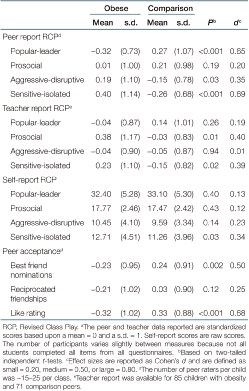 |
Behavioral reputation
Behavioral reputation for obese children and comparison peers was evaluated from the perspectives of peers, teachers, and the child's self-report on the RCP (Table 1). Relative to comparison peers, obese children were described as more sensitive and isolated by peer-, teacher-, and self-reports. In addition, peers perceived obese children as displaying significantly less leadership behavior and greater aggressive-disruptive behavior than comparison peers. In contrast to these perceptions of social difficulties, teachers described obese children as significantly more prosocial than comparison peers.
Nonsocial attributes and health interference
Groups of children were compared on RCP roles related to peer perceptions of physical attractiveness, athletic ability, academic competence, and health interference items (Table 2). Peers described obese children as less attractive and less athletically skilled than comparison peers, but groups were not different in peer perceptions of academic competence. For those RCP roles related to health interference, peers perceived obese children as more ill, missing school more frequently, and more fatigued than comparison peers.
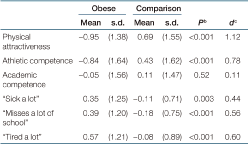 |
Pearson correlations of peer reported nonsocial attributes and health interference with social functioning are reported in Table 3 for obese children and comparison peers. In general, peer-perceived attractiveness and athletic competence were strongly associated with peer-reported behavioral reputation and social acceptance for both groups of children.
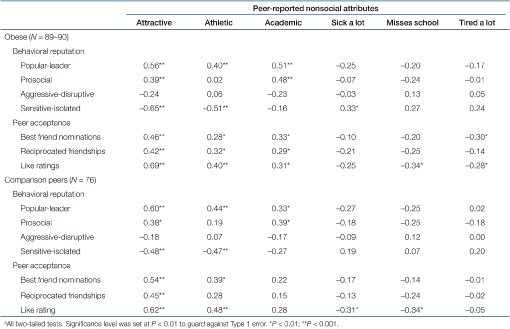 |
Gender, race, and grade
Exploratory analyses were conducted to examine whether significant interactions occurred between group status (obese vs. comparison) and gender, race, or grade. No significant interactions were identified for any outcome variables (e.g., behavioral reputation, peer acceptance, nonsocial, and health interference attributes).
Nonsocial attributes as mediators of peer acceptance
Hierarchical regression analyses were completed to test whether peer perceptions of nonsocial attributes explained the association between being obese and peer acceptance (e.g., like ratings). Variables were considered potential mediators, if they demonstrated a significant correlation with obesity status (obese vs. comparison) and with like ratings.
Peer perceptions of attractiveness and athletic ability had significant associations with obesity status and like ratings and, thus, were considered potential mediators (1). In the regression analysis, obesity status was entered in step 1 (Change in R2 = 0.10, P < 0.001), and the two nonsocial attributes were entered in step 2 (Change in R2 = 0.39, P < 0.001). The unstandardized β weight for obesity status was reduced to nonsignificance after the nonsocial variables were entered into the model. Post-hoc analyses using the bootstrap method indicated that as a set, attractiveness and athletic ability were significant mediators (95% confidence interval = −0.98 to −0.52). The indirect effects through each variable were also significant (Attractiveness: estimated unstandardized β = −0.62, 95% confidence interval around β = −0.88 to −0.43; athletic ability: estimated unstandardized β = −0.10, 95% confidence interval around β = −0.23 to −0.01). However, the indirect effect through attractiveness was significantly larger in magnitude than the indirect effect through athletic ability (95% confidence interval = −0.83 to −0.31).
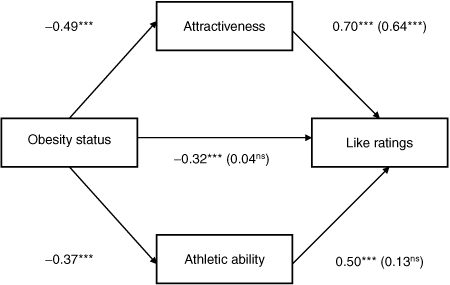
: Model of peer perceptions of nonsocial attributes mediating the association between child obesity status and peer reported like ratings. Child obesity status was coded as: 0 = nonoverweight comparison peer and 1 = obese. Path values not in parentheses are zero order correlations; path values in parentheses are standardized β coefficients from the regression equation with the other predictors included. ***P < 0.001. ns, nonsignificant.
Discussion
This study demonstrates that the peer group provides a rich and important context within which one can examine not only the social consequences of pediatric obesity, but potentially, factors that could be targeted in intervention. Obese children were rated as lower in peer acceptance (e.g., like ratings) than nonoverweight comparison peers. This finding is in contrast to several studies that have indicated no differences between obese and nonoverweight children (38,39). However, unlike this previous research, this study utilized a demographically matched comparison group, included a larger sample with a broader age range, and represented a clinically referred vs. a community sample. Regarding the measure of friendship, obese children and adolescents were nominated significantly less often by classmates as a friend, consistent with findings reported by Strauss and Pollack (40) in a large epidemiological sample. However, obese youth did not differ from nonoverweight comparisons in the number of reciprocated friendships, with the majority of obese youth having at least one mutual friendship in the classroom. Taken together, the present data indicate that while clinically referred obese children and adolescents are less liked overall and have fewer friends in a classroom environment, the majority are not friendless and, in fact, know who their friends are.
Clinically referred obese youth also exhibited social behaviors that are not conducive to positive peer interactions. Peers perceived obese children as displaying significantly less leadership behavior and as being more aggressive and disruptive than nonoverweight comparison peers. These are not the first data to indicate that obese youth may engage in negative peer behaviors. For example, in an observational study (38), children who were overweight received and initiated more negative interactions with peers relative to nonoverweight children. Further, obese adolescents self-reported being victims as well as perpetrators of verbal bullying among peers (16). However, what is most striking is that across informants (peer, teacher, self), obese children were also characterized as engaging in more socially withdrawn behaviors.
Based on the broader peer relations literature, these findings place obese youth at considerable psychosocial risk, with ramifications for both their psychological adjustment and longer term developmental adaptation (8,10,11). In particular, developmental research has shown that socially withdrawn children become adolescents and adults who experience difficulties with self-esteem and depression, have less social involvement, and show delays in age-salient developmental tasks such as job competence, getting married, and having children (9,56,57,58).
This study also demonstrated that other “nonsocial” attributes differentiated obese and nonoverweight youth. Peers perceived obese youth as less attractive and less athletically competent than nonoverweight comparisons, although the two groups did not differ in peer perceptions of academic competence. Moreover, being seen as less attractive and less athletic by peers helped to explain differences in obese and nonoverweight youth's levels of peer acceptance. These data are consistent with developmental literature which has linked peer acceptance with attractiveness and athletic ability for youth in general (13). Relative to comparisons, peers also perceived obese children as missing more school and as more “sick” and “tired.” We have no objective data to support these peer perceptions of reduced school attendance. It is noteworthy that the present sample was enrolled in a pediatric weight management program. Although designed to accommodate school schedules, program attendance may have impacted school attendance. However, previous studies have documented that obese youth experience more school absences before engaging in treatment (59) as do obese youth in a community sample (60). Taken together, the present data provide empirical support that the social consequences of pediatric obesity are related to the visible nature of the condition, as well as peer perceptions of the restrictions obesity places on engaging in peer-based physical activities and daily age-normative activities.
How to best intervene at the peer level remains an empirical question, and there is considerable work to be done. For the obese child or adolescent, the development of adjunctive interventions targeting age-appropriate skills and strategies for improved peer group integration are clinically indicated. However, the present data speak of a broader intervention target, namely peers within the school environment. We have previously documented that obese youth report lower perceived social support from classmates compared to friends, teachers, or parents, with lower classmate social support being a significant predictor of poorer health-related quality of life (61). In addition, we know that for adolescents in general there is evidence that having more friendships is associated with watching fewer hours of television and greater involvement in school-based clubs and sporting activities (40). Further, children are more likely to engage in physical activity if there is peer social support (62). Peer-based educational interventions are needed to increase acceptance of obese children and to reduce the negative attitudes and behaviors directed at them (27,63). In addition, interventions designed to promote healthful eating and increase physical activity in the school environment for all students will likely result in improved health and psychosocial functioning.
This study represents the first examination of the relations between peer acceptance, social behaviors, and nonsocial attributes in obese youth; however several limitations were noted with consequent directions for future research. First, these data characterize a clinically referred sample of obese children and adolescents. Further research is critical to better understand whether these peer relationship patterns are also typical of obese youth in the broader community who do not or cannot access care. In particular, the addition of a nontreatment-seeking demographically similar obese comparison group would be useful in clarifying this issue. It is possible that obese children who present to clinical obesity programs are experiencing greater social difficulties. For instance, in a Turkish adolescent sample, Erermis and colleagues (64) reported that clinically referred youth were described by mothers as being more socially withdrawn than either a nonreferred group or nonoverweight comparisons. Second, while we did not find evidence of race, gender, or grade effects in our exploratory analyses, these potential differences may become more evident when utilizing a larger sample. For example, when examining friendship patterns within the Add Health sample, Strauss and Pollack (40) documented that the social marginalization of obese adolescents was most prominent for non-Hispanic whites, and girls in particular, with smaller effects for Hispanic/Latino and African-American adolescents. Given cultural contexts where obesity is less stigmatized (65) or “so common as to appear normative”, (66) it will be important to examine whether being obese differentially affects youth of varying race/ethnic groups and how this may translate into culturally specific barriers to treatment success and maintenance. Finally, the cross-sectional nature of this study limits our ability to draw causal or directional conclusions. Unfortunately, we do not know what role negative peer relations play in obesity's development, persistence, or progression to extreme levels from childhood to adolescence to adulthood. Although not all obese children will become obese adolescents, the majority (50–80%) will remain obese in adulthood (67,68,69). Prospective longitudinal studies which document weight and psychosocial trajectories, their interrelations, and what role peer relations plays in these trajectories is an important area of future research vital to the advancement of the field.
Disclosure
The authors declared no conflict of interest.
Acknowledgments
This research was funded by a grant from the National Institutes of Health (K23 DK60031) awarded to the first author. M.H.Z. acknowledges the expert guidance and teaching of her K23 mentoring team, and specifically, the consultation provided by Drs Vannatta and Noll in the utilization of the present research design. This work could not have been completed without the talented and dedicated research staff led by C.R., which included Lindsay Wilson, Allison Sullivan, Brad Huth, Amanda Arthur, Melissa Foti-Hoff, Rhonda Allen, and Susannah Coaston.



